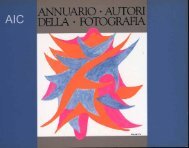AIC, 1988 - AIC Associazione Italiana Autori della Fotografia ...
AIC, 1988 - AIC Associazione Italiana Autori della Fotografia ...
AIC, 1988 - AIC Associazione Italiana Autori della Fotografia ...
You also want an ePaper? Increase the reach of your titles
YUMPU automatically turns print PDFs into web optimized ePapers that Google loves.
<strong>AIC</strong><br />
"Sudan subacqueo" di G. Lorenzo Battaglia<br />
dell'avventura, e Folco Quilici,<br />
grande giornalista e scrittore.<br />
Entrambi si sono valsi dell'opera<br />
di operatori subacquei di grande<br />
esperienza, come il compianto<br />
Masino Manunza ed il sempre<br />
valido Armando Mattei: molto<br />
del successo dei grandi è legato a<br />
questi due ultimi nomi.<br />
Scrivere di fotografia subacquea<br />
richiederebbe troppo tempo e<br />
altrettanto spazio.<br />
Schematicamente ne parleremo<br />
così:<br />
La luce nel mare: assorbimento —<br />
diffusione — polarizzazione dei<br />
riflessi - come un soggetto riceve<br />
la luce.<br />
L'occhio del mare: scherzi <strong>della</strong><br />
rifrazione — come funziona un<br />
oblò — l'obiettivo nel mare —<br />
l'oblò correttore — la pressione<br />
dell'acqua.<br />
La custodia: impermeabilità —<br />
tenuta — corrosione — visione<br />
reflex.<br />
Luce: artificiale e naturale.<br />
Argomenti importantissimi tutti<br />
che sviluppati richiedono tanto<br />
spazio forse quanto tutto<br />
1 Annuario.<br />
L anomalo comportamento <strong>della</strong><br />
luce sott'acqua sarebbe un<br />
fenomeno interessante da<br />
studiare per i colleghi direttori di<br />
fotografia e per lo stesso<br />
pubblico.<br />
Come si sa, la luce del sole, detta<br />
per convenzione "bianca", è in<br />
effetti composta da radiazioni di<br />
colori differenti: viola, blu,<br />
verde, giallo, arancio, rosso, ecc.,<br />
individuati nelle varie lunghezze<br />
d'onda. L'estinzione <strong>della</strong> luce in<br />
mare con l'aumento <strong>della</strong><br />
profondità non avviene in modo<br />
lineare per tutte le lunghezze<br />
d'onda, cioè per tutti i colori.<br />
Ma, prima ad estinguersi è la<br />
radiazione corrispondente al<br />
rosso, poi l'arancione ed il giallo,<br />
colori che sotto i dieci metri di<br />
profondità non si scorgono più. Il<br />
blu e il verde, le corte lunghezze<br />
d'onda, sono i colori dominanti<br />
sotto i dieci metri. Questo in<br />
linea generale, in quanto molto<br />
dipende anche dalla colorazione<br />
propria dell'acqua che varia per<br />
il plankton e per altri fenomeni.<br />
Per questo, se si desidera<br />
ottenere sotto i dieci metri colori<br />
saturi e reali, conviene usare la<br />
luce artificiale con temperatura<br />
di colore sui 3400°K, ossia più<br />
calda. Questo compensa in parte<br />
l'eccesso di blu dovuto alla<br />
profondità.<br />
Tuttavia, le luci artificiali<br />
sott'acqua sono utili soltanto per<br />
distanze entro un metro e mezzo<br />
massimo. Usando luci molto<br />
intense si può ottenere qualcosa<br />
di più, ma non molto.<br />
Ora, dovendo dare un consiglio<br />
alle nuove leve di operatori,<br />
ansiose di specializzarsi in questo<br />
campo, potrei suggerire di far le<br />
cose per gradi. L'operatore<br />
subacqueo esercita un mestiere<br />
duro e faticoso, molti i pericoli<br />
per la salute cui si va incontro, e<br />
pertanto un mestiere simile va<br />
affrontato con grande cautela.<br />
Conseguire un brevetto ad alto<br />
livello di immersione, e fare un<br />
tirocinio con qualcuno dei pochi<br />
operatori subacquei professionisti<br />
esistenti, è un obbligo cui non si<br />
può sfuggire.<br />
Underwater Photography is what one<br />
might call a specialized branch of<br />
photography.<br />
All the techniques that have been<br />
invented are the merit of<br />
photographers who have a great<br />
rapport with the sea, appreciate its<br />
beauty and know its dangers. Amongst<br />
the pioneers of underwater<br />
photography, 1 would like to mention<br />
Louis Boutan, who was in many<br />
respects an unusual personality. A<br />
science lecturer at the Sorbonne, he<br />
had neither the character, nor physique<br />
one would normally associate with a<br />
man of letters.<br />
He was a big, powerfully built man,<br />
and had a great knowledge of the<br />
world. He alternated periods of study<br />
at his desk with periods in the open<br />
air, during which he conducted his<br />
photographic experiments. It was the<br />
year 1880, or thereabouts, and the<br />
majority of photographers were still<br />
using the collodion process which<br />
required that the film was used wet<br />
arul laid on the plate immediately<br />
before the photograph was taken. Not<br />
a process for using underwater!<br />
Boutan chose to use the "dry" film<br />
that had then only recently appeared<br />
on the market. He encountered many<br />
problems which he attempted to solve<br />
with the Lumière brothers (this was in<br />
the summer of 1893/94). The first<br />
results were somewhat disappointing.<br />
Later, when he had improved both the<br />
camera end the casing, he succeeded in<br />
taking some excellent photographs,<br />
many of which were published.<br />
For this reason, Boutan must be<br />
counted as one of the pioneers of<br />
underwater photography. He also<br />
wrote a book on the subject: "La<br />
Photographie sous Marine et le progrès<br />
de la Photographie", which was<br />
published in 1900, and was the<br />
forerunner of the many books that<br />
followed on the subject.<br />
He carried out other research in<br />
related fields, discovering how to<br />
reproduce cultured pearls, the secret of<br />
which he revealed in a report.<br />
The process also made him rich and









